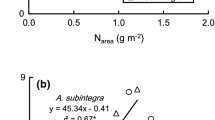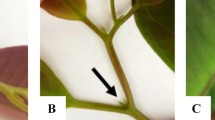Abstract
The environment in which plants are inserted offers numerous stimuli that can influence plant ecophysiology and metabolism. Garcinia brasiliensis is a plant species of high interest for secondary metabolites extraction, however the comprehension about its behavior in response to environmental stimuli is still scarce. Thus, this study aimed to identify the influence of seasonality on the ecophysiology, biochemistry and anatomy of G. brasiliensis, aiming to contribute for the preservation and conservation of native populations and the propagation of this species. Evaluations were carried out under field conditions on six-year-old adult plants, in four replications over four months of the year (May, September, November and February). The evaluations were carried out in the middle third of the canopy, in fully expanded leaves. Gas exchange, chlorophyll “a” fluorescence, relative chlorophyll content, leaf water potential, carbohydrate, protein and amino acid content, and leaf anatomy were assessed. Gas exchange and production of carbohydrates and proteins were higher in November, when there was the highest rainfall rate. The maximum efficiency of the photochemical process in PSII was higher in February. Seasonality influences gas exchange, chlorophyll “a” fluorescence, production of primary metabolites and the nutritional status of G. brasiliensis plants. Anatomical changes are the least pronounced due to seasonal variations. Plants were more active metabolically in November, a month typical of spring in Brazilian tropical climate, which also corresponds to the growth season.







Similar content being viewed by others
References
Amorim MW, De Melo Júnior JCF (2017) Plasticidade morfoanatômica foliar de Tibouchina clavata (Melastomataceae) ocorrente em duas formações de restinga. Rodriguesia 68:545–555. https://doi.org/10.1590/2175-7860201768217
Bahamonde HA, Gil L, Fernández V (2018) Surface properties and permeability to calcium chloride of Fagus sylvatica and Quercus petraea leaves of different canopy heights. Front Plant Sci 9:1–13. https://doi.org/10.3389/fpls.2018.00494
Bosabalidis AM, Kofidis G (2002) Comparative effects of drought stress on leaf anatomy of two olive cultivars. Plant Sci 163:375–379. https://doi.org/10.1016/S0168-9452(02)00135-8
Bradford MM (1976) A rapid and sensitive method for the quantitation of microgram quantities of protein utilizing the principle of protein-dye binding. Anal Biochem 72:248–254
Cai M, Ding W, Zhai J et al (2020) Photosynthetic compensation of non-leaf organ stems of the invasive species Sphagneticola trilobata (L.) Pruski at low temperature. Photosynth Res 1:1–14. https://doi.org/10.1007/s11120-020-00748-5
Chen J, Bi H, Yu X, Fu Y, Liao W (2019) Influence of physiological and environmental factors on the diurnal variation in emissions of biogenic volatile compounds from Pinus tabuliformis. J Environ Sci 81:102–118. https://doi.org/10.1016/j.jes.2019.01.020
Fernandez CMM, Lorenzetti FB, Iwanaga CC et al (2021) Chemical composition and seasonal variation of the essential oils of leaves of Garcinia gardneriana (Planchon & Triana) Zappi (Clusiaceae). Aust J Crop Sci 15:1–8. https://doi.org/10.21475/ajcs.21.15.01.1800
Hernández Y, González K, Valdés-iglesias O et al (2016) Seasonal behavior of Thalassia testudinum (Hydrocharitaceae) metabolites. Rev Biol Trop 64:1527–1535
Ishida A, Diloksumpun S, Ladpala P et al (2006) Contrasting seasonal leaf habits of canopy trees between tropical dry-deciduous and evergreen forests in Thailand. Tree Physiol 26:643–656. https://doi.org/10.1093/treephys/26.5.643
Jassey VEJ, Signarbieux C (2019) Effects of climate warming on Sphagnum photosynthesis in peatlands depend on peat moisture and species-specific anatomical traits. Glob Chang Biol 25:3859–3870. https://doi.org/10.1111/gcb.14788
Jolliffe IT, Cadima J (2016) Principal component analysis: a review and recent developments. Philos Trans R Soc A Math Phys Eng Sci 374:20150202. https://doi.org/10.1098/rsta.2015.0202
Kauwe MG, Medlyn BE, Pitman AJ et al (2019) Examining the evidence for decoupling between photosynthesis and transpiration during heat extremes. Biogeosciences 16:903–916. https://doi.org/10.5194/bg-16-903-2019
K. Roháček K (2002) Chlorophyll Fluorescence Parameters: The Definitions, Photosynthetic Meaning, and Mutual Relationships. Photosynthetica 40:13–29. https://doi.org/10.1023/A:1020125719386
Kumar S, Sharma S, Chattopadhyay SK (2013) The potential health benefit of polyisoprenylated benzophenones from Garcinia and related genera: Ethnobotanical and therapeutic importance. Fitoterapia 89:86–125. https://doi.org/10.1016/j.fitote.2013.05.010
Lambers H, Stuart Chapin F III, Pons TL (2008) Plant physiological ecology. Springer Science & Business Media, New York
Lemos VOT, De Lucena EMP, Bonilla OH et al (2018) Ecological anatomy of Eugenia luschnathiana (O. Berg) Klotzsch ex B. D. Jacks. (Myrtaceae) leaves in the Restinga region, state of Ceara. Rev Bras Frutic 40:e696. https://doi.org/10.1590/0100-29452018696
Liu W, Su J, Li S, Lang X, Huang X (2018) Non-structural carbohydrates regulated by season and species in the subtropical monsoon broad-leaved evergreen forest of Yunnan Province, China. Sci Rep 8:1083. https://doi.org/10.1038/s41598-018-19271-8
Li Y, Kong D, Fu Y, Sussman MR, Wu H (2020) The effect of developmental and environmental factors on secondary metabolites in medicinal plants. Plant Physiol Biochem 148:80–89. https://doi.org/10.1016/j.plaphy.2020.01.006
Malavolta E, Vitti G, Oliveira S (1997) Avaliação do estado nutricional das plantas. Princípios e aplicações. Potafos, Piracicaba
Marchiori NM, Silva JG, Santos FC et al (2019) Effects of seasonal air temperatures and light on leaf traits at Atlantic Montane Forest, brazilian Southeast. Cerne 25:263–272. https://doi.org/10.1590/01047760201925032625
Martins FT, Doriguetto AC, de Souza TC et al (2008) Composition, and anti-inflammatory and antioxidant activities of the volatile oil from the fruit peel of Garcinia brasiliensis. Chem Biodivers 5:251–258. https://doi.org/10.1002/cbdv.200890022
Melo AM, Almeida FLC, Cavalcante AMM et al (2021) Garcinia brasiliensis fruits and its by-products: antioxidant activity, health effects and future food industry trends – A bibliometric review. Trends Food Sci Technol 112:325–335. https://doi.org/10.1016/j.tifs.2021.04.005
Miller GL (1959) Use of dinitrosalicylic acid reagent for determination of reducing sugar. Anal Chem 31:426–428
Mirsoleimani A, Shahsavar A, Rowshan V (2018) Changes of phenolic compounds and non-structural carbohydrates on alternate bearing cycle in “Kinnow” mandarin trees. J Plant Process Funct 7:39–48
Morais L (2009) Influência dos fatores abióticos na composição química dos óleos essenciais. Hortic Bras 27:4050–4063
Naves VML, dos Santos MH, Ribeiro IS et al (2019) Antimicrobial and antioxidant activity of Garcinia brasiliensis extracts. South Afr J Bot 124:244–250. https://doi.org/10.1590/S1516-05722013000300013
Ogaya R, Peñuelas J, Asensio D, Llusià J (2011) Chlorophyll fluorescence responses to temperature and water availability in two co-dominant Mediterranean shrub and tree species in a long-term field experiment simulating climate change. Environ Exp Bot 71:123–127. https://doi.org/10.1016/j.envexpbot.2010.10.016
Oliveira MT, Souza GM, Pereira S et al (2017) Seasonal variability in physiological and anatomical traits contributes to invasion success of Prosopis juliflora in tropical dry forest. Tree Physiol 37:326–337. https://doi.org/10.1093/treephys/tpw123
Osório ML, Osório J, Romano A (2010) Chlorophyll fluorescence in micropropagated Rhododendron ponticum subsp. baeticum plants in response to different irradiances. Biol Plantarum 54:415–422. https://doi.org/10.1007/s10535-010-0076-1
Piccinelli AL, Cuesta-Rubio O, Chica MB et al (2005) Structural revision of clusianone and 7-epi-clusianone and anti-HIV activity of polyisoprenylated benzophenones. Tetrahedron 61:8206–8211. https://doi.org/10.1016/j.tet.2005.06.030
Poorter H, Nagel O (2000) The role of biomass allocation in the growth response of plants to different levels of light, CO2, nutrients and water: a quantitative review. Aust J Plant Physiol 27:595–607
Rabêlo VM, Magalhães PC, Bressanin LA et al (2019) The foliar application of a mixture of semisynthetic chitosan derivatives induces tolerance to water deficit in maize, improving the antioxidant system and increasing photosynthesis and grain yield. Sci Rep 9:8164. https://doi.org/10.1038/s41598-019-44649-7
Raij BV, Andrade JC, Cantarella H, Quaggio JA (2001) Análise química para avaliação da fertilidade de. solos tropicais. Instituto Agronômico, Campinas
Ramírez-Briones E, Rodríguez-Macías R, Salcedo-Pérez E et al (2017) Seasonal variation in non-structural carbohydrates, sucrolytic activity and secondary metabolites in deciduous and perennial Diospyros species sampled in Western Mexico. PLoS ONE 12:e0187235. https://doi.org/10.1371/journal.pone.0187235
Ramírez-Valiente JA, López R, Hipp AL, Aranda I (2020) Correlated evolution of morphology, gas exchange, growth rates and hydraulics as a response to precipitation and temperature regimes in oaks (Quercus). New Phytol 227:794–809. https://doi.org/10.1111/nph.16320
Ribeiro JES, Barbosa AJS, Lopes SDF et al (2018) Seasonal variation in gas exchange by plants of Erythroxylum simonis Plowman. Acta Bot Brasilica 32:287–296. https://doi.org/10.1590/0102-33062017abb0240
Romanatti PV, Rocha GA, Veroneze Júnior V et al (2019) Limitation to photosynthesis in leaves of eggplant under UVB according to anatomical changes and alterations on the antioxidant system. Sci Hortic (Amsterdam) 249:449–454. https://doi.org/10.1016/j.scienta.2019.01.060
Roosta HR, Estaji A, Niknam F (2018) Effect of iron, zinc and manganese shortage-induced change on photosynthetic pigments, some osmoregulators and chlorophyll fluorescence parameters in lettuce. Photosynthetica 56:606–615. https://doi.org/10.1007/s11099-017-0696-1
Sharma S, Joshi J, Kataria S et al (2020) Regulation of the Calvin cycle under abiotic stresses: an overview. In: Tripathi DK et al (eds) Plant Life under changing Environment. Academic Press, London, pp 681–717. https://doi.org/10.1016/B978-0-12-818204-8.00030-8
Shtein I, Meir S, Riov J, Philosoph-Hadas S (2011) Interconnection of seasonal temperature, vascular traits, leaf anatomy and hydraulic performance in cut Dodonaea ‘Dana’ branches. Postharvest Biol Technol 61:184–192. https://doi.org/10.1016/j.postharvbio.2011.03.004
Stojnić S, Kovačević B, Kebert M et al (2019) The use of physiological, biochemical and morpho-anatomical traits in tree breeding for improved water-use efficiency of Quercus robur L. For Syst 28:e017. https://doi.org/10.5424/fs/2019283-15233
Tassoni A, Zappi A, Melucci D, Reisch BI, Davies PJ (2019) Seasonal changes in amino acids and phenolic compounds in fruits from hybrid cross populations of american grapes differing in disease resistance. Plant Physiol Biochem 135:182–193. https://doi.org/10.1016/j.plaphy.2018.11.034
Tekaya M, Mechri B, Dabbaghi O et al (2016) Changes in key photosynthetic parameters of olive trees following soil tillage and wastewater irrigation, modified olive oil quality. Agric Water Manag 178:180–188. https://doi.org/10.1016/j.agwat.2016.09.023
Veroneze Junior V, de Souza KRD, Bressanin LA et al (2022) Seasonal changes of physiological and biochemical characteristics of Garcinia brasiliensis leaves. South Afr J Bot 147:349–358. https://doi.org/10.1016/j.sajb.2022.01.041
Watermann PG (1986) Medicinal plants in tropical West Africa: by Bep Oliver-Bever. Cambridge University Press, Cambridge
Xu H, Vavilin D, Vermaas W (2001) Chlorophyll b can serve as the major pigment in functional photosystem II complexes of cyanobacteria. Proc Natl Acad Sci 98:14168–14173. https://doi.org/10.1073/pnas.251530298
Yemm EW, Cocking EC, Ricketts RE (1955) The determination of amino-acids with ninhydrin. Analyst 80:209–214
Yemm EW, Willis AJ (1954) The estimation of carbohydrates in plant extracts by Anthrone. Biochem J 57:508–514. https://doi.org/10.1042/bj0570508
Zanandrea I, Nassi FL, Turchetto AC et al (2006) Effect of salinity under fluorescence parameters in Phaseolus vulgaris. Rev Bras Agrociência 12:157–161
Zan RA, Fernandes Â, Jedoz S et al (2018) Bioactive properties and phytochemical assessment of Bacupari-anão (Garcinia brasiliensis Mart.) Leaves native to Rondônia, Brazil. Food Funct 9:5621–5628. https://doi.org/10.1039/C8FO01474D
Acknowledgements
The authors would like to thank CAPES (Financing Code 001), FAPEMIG and CNPq for the financial support.
Author information
Authors and Affiliations
Contributions
VVJ: Investigation; Writing - Original Draft; Writing - Review & Editing; Visualization; KRDS: Conceptualization; Writing - Original Draft; Writing - Review & Editing; LAB: Writing - Original Draft; Writing - Review & Editing; GFE: Investigation; TCSM: Methodology; Investigation; MGS: Methodology; Writing - Review & Editing; TCS: Conceptualization; Resources; Writing - Review & Editing; Supervision.
Corresponding author
Ethics declarations
Competing interests
The authors have no competing interests to declare that are relevant to the content of this article.
Additional information
Publisher’s Note
Springer Nature remains neutral with regard to jurisdictional claims in published maps and institutional affiliations.
Rights and permissions
Springer Nature or its licensor (e.g. a society or other partner) holds exclusive rights to this article under a publishing agreement with the author(s) or other rightsholder(s); author self-archiving of the accepted manuscript version of this article is solely governed by the terms of such publishing agreement and applicable law.
About this article
Cite this article
Veroneze, V., de Souza, K.R.D., Bressanin, L.A. et al. Modifications in morphopysiological characteristics of Garcinia brasiliensis leaves in response to seasonal variations. Biologia 78, 3003–3015 (2023). https://doi.org/10.1007/s11756-023-01431-5
Received:
Accepted:
Published:
Issue Date:
DOI: https://doi.org/10.1007/s11756-023-01431-5




